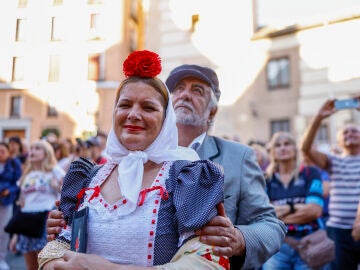
San Isidroone of the most important festivities for the Madrid capital, blooms, never better said, in spring, and it is that between the Wednesday May 10 and Monday May 15 Madrid dresses in its striking manila shawls, moves to the rhythm of the chotis, tastes of Donuts and it smells like carnation.
During these days, the most authentic Madrid men and women bring out their mythical and unmistakable chulapa and chulapo costumes to celebrate this holiday. These outfits, specifically the dress of the chulapaswhich consists of a tight-fitting dress decorated with polka dots or flowers and ruffles, a white handkerchief and a manila shawl, is accompanied by a very special detail, some carnations.
As Agustín Lara already said in the most famous songbook that resonates in San Isidro, “When you arrive in Madrid, my chulona, I’m going to make you empress of Lavapiés; and carpet the Gran Vía with carnations“. There is white, red and pink carnationsthey can be carried one, two or three and they must be placed in the white handkerchief folded in the shape of a beak that the chulapas put on their heads.
The variety of color range of carnations has a different meaning for each hue. He white carnation represents purity and innocence, the red carnation is synonymous with love and admiration while the pink carnation means unconditional love (from mothers to children).
Although there is no historical writing or references about the meaning attributed to the carnations in the handkerchief that is placed on the head of the chulapas, it has been transmitted orally between generations of Madrid residents. meaning of its use, number and color in this festivity:
- two red carnations: the chulapa is married
- two white carnations: the chulapa is single
- One white and one red carnation: the chulapa is engaged or with a boyfriend
- Two red carnations and one white: the chulapa is a widow
- a pink carnation: the chulapa is a girl
Where does the name chulapo and chulapa come from?
Besides all the music programming that takes place during the San Isidro festivities, the popularity of its donuts and its mythical chotis dance, the main protagonists of this Madrid festival are the chulapos and the chulapas of the capital. The meaning of these names goes back to the end of the 19th century and the beginning of the 20th, when the residents of the popular neighborhoods of Malasaña and Maravillas were looking for stand out from the Frenchified social elite with “affection and handsomeness in the suit and in the way of conducting themselves” according to the dictionary of the RAE, the same one that defines pimp as “person of the popular classes of Madrid”.
What does the expression “cooler than an eight” mean?
The people of Madrid have fame of pimps and pimps. Whether it is because of their way of walking, their elegant fairground costumes in San Isidro or the frenetic and conquering rhythm with which they perform when dancing, what is clear is that a man from Madrid is seen coming from afar because they are “cooler than an eight”. Surely you have asked yourself more than once what the word chulería has to do with the number eight, well, this phrase alludes to the tram that, having the number eight, connected the Puerta del Sol with San Antonio de la Florida (La prairie) to take all the chulapos and chulapas who lived in the vicinity of Puerta del Sol to the place where the festival (San Isidro) was celebrated.
Source: Lasexta
Bruce is a talented author and journalist with a passion for entertainment . He currently works as a writer at the 247 News Agency, where he has established himself as a respected voice in the industry.











